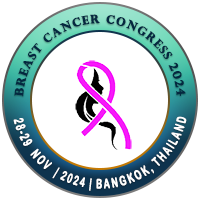7.jpg)
Mohamed Ali Mlees
Tanta University, EgyptTitle: Diagnosis and surgical treatment of pathologic nipple discharge using ultrasound?guided wire localization of focal ductal dilatation
Abstract
Background and aim:
Nipple discharge is the third breast complaint after pain and lumps. The modern high?resolution ultrasound techniques are becoming more sensitive for the visualization of intraductal changes especially focal ductal dilatation (FDD), hypothesized as a radiographic manifestation of the lesion itself and that ultrasound?guided wire localization of this finding would enable identification and excision of the causative lesion. The aim of this study was to evaluate the safety, feasibility, efficiency and outcome of ultrasound?guided wire localization of FDD as possible cause of pathological nipple discharge (PND).
Patients and methods:
The present study was conducted on 56 patients with PND presented to Surgical Oncology Unit at General Surgery Department, Tanta University Hospital from January 2018 to January 2019. The patients subjected to ultrasound?guided wire localization of FDD on the day of surgery, the involved duct was cannulated with a lacrimal duct probe, the targeted tissue was excised, and the specimen was sent for histopathological examination.
Results:
The patients' age ranged be? tween 26 and 71 years with a mean age of 48 years. The bloody nipple discharge was the commonest presenting symptom in 44 out of 56 patients (78.5%). The duct dilatation on study ultrasound ranged from 2.1 to 3.7 mm with a mean of 2.6 mm. Preoperative ultrasound?guided wire localization of the site of FDD was successfully performed in all cases. Papilloma alone founded in 40 out of 56 patients (71.4%), papilloma + ductal carcinoma in situ (DCIS) in six patients (10.7%), papilloma + invasive ductal carcinoma in six patients (10.7%), DCIS in two patients (3.6%) and duct ectasia in two patients (3.6%).
Conclusion:
Ultrasound?guided wire localization of FDD is an easy and safe technique for evaluation, precise localization, and targeted excision of the underlying lesions of PND.
Biography
To be updated soon.

